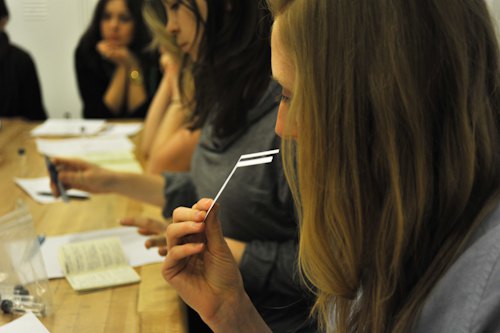
Everyone has an inexplicable attraction to smell – it’s biology. Most women rely on their favorite store-bought designer fragrances, whether floral, spicy, citrus, woody or musky. But what do we really know about where the scents in our little pink bottles come from? After all, the scents that we adorn ourselves with are largely synthetic, no longer reliant on the plant-based process of perfume-making that’s been around for thousands of years. 3rd Ward is currently offering a course that takes the history of perfume, lays it all in tiny essential oil vials, and allows you to experience it firsthand. The Art of Perfume Making is a class as fun as it was informative, enlightening to the mind and to the senses.

History Scents: From Egypt to Chanel No. 5
We started off the class with a history of scents. Perfume-making originated in Egypt and was continued by the Romans and Greeks. Did you know we’ve worn about 10-15 scents since ancient times? Some of the classics include frankincense, myrrh, and labdanum. In the 1500s, the number of scents in production started multiplying after the invention of distillation, or the process of extracting scents from flowers, and its widespread use. The first synthetic scent was created in 1889, the famous Chanel No. 5. The high notes, the low notes, the sweet, the savory, the spice and the musk – these are made up of synthetic aroma compounds, often made from petrochemicals, which include phthalates. There are many reasons that olfactory experts recommend avoiding synthetic scents, including some serious health risks and the fact that they simply do not feel the same to the nose and body as natural scents do.


Balanced Perfume = Whole Science
Natural perfumes are made from a blend of essential oils, absolutes, and hydrosols atop an odorless alcohol. These scents are categorized into families, such as woody, resinous, balsamic, animal, earthy, green, narcotic, rosy, spicy, flowery, and dry. They contain bottom, middle, and top notes. A good perfume balances these notes in perfect harmony. A natural perfume adapts to everyone’s skin differently. The aroma will change as each layer of scent wears off, the whole experience is much more ephemeral. First the high notes will fade into the middle notes, then those too will fade and the bottom notes, your base scent, will linger the longest. So, it’s natural to start building a scent from the base note. Famous base notes include: Sandalwood, Tobacco, Musk, Vetiver, Vanilla, Patchouli, Cognac, and the ancient ones mentioned earlier. To blend a scent that smells clean and not too murky, you need to have a working knowledge of the oils available to you, and a heightened sense of smell helps. Luckily, we had ample time to learn about, smell, and sample at least 15 scents of each level of note.


Middle notes are Sexy…
Once you’ve used a few different base notes that complement each other’s aromas – it’s all a balancing act – you’re ready to blend in some middle notes. Middle notes are also known as heart notes because these are the sexy scents; many are sensuous and even aphrodisiacs. Some of the popular scents here include: Jasmine, Rose, Geranium, Cinnamon, Magnolia, Ylang Ylang, and Lemon Verbana. Adding one drop at a time, you begin to create a sort of aromatic elixir, although in the beginning it’s all a guessing game as you witness the smells react and hope for the best.


Elevate Yourself with Top Notes!
To finish of your scent in a balanced way, you’ll have to have a good grasp of the different levels of smells, and which ones work well together. Top notes are always essential oils and they elevate the fragrance to a light, sweet finish. Some examples of these include Lime, Bitter Orange, Wintergreen, Ginger, Pepper, Lavender, Cedar wood, Cucumber and many more attractive, well-known scents that you often find imitated on store shelves.


Our guide through the world of essential oils was Julianne Zaleta, founder of Herbal Alchemy Apothecary. She is an admirable perfumist and extremely knowledgeable in the niche world of aromas. Answering any and all questions while she guided us through the creation of our own scents, she was our own personal fragrance guru. In the end, we walked away with two vials of scents each. The firs t- a (likely muddled) learning lesson, really a trial and error creation that’s hopefully awesome anyway. The second, if a success, is a sweet and balanced perfume, perfectly suited to you. Something that you will enjoy wearing (and touting) for a long time to come!
The Art of Perfume Making is offered periodically at 3rd Ward Brooklyn. The next workshop is scheduled for August 3rd. We highly recommend checking it out.


